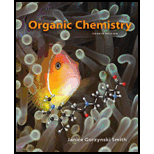
Concept explainers
(a)
Interpretation: The bond angles in the given compound are to be predicted with the help of its given Lewis structure.
Concept introduction: The geometry and hybridisation of an atom is determined by the number of groups around it. If the number of groups attached to an atom is
(b)
Interpretation: The bond angles in the given compound are to be predicted with the help of its given Lewis structure.
Concept introduction: The geometry and hybridisation of an atom is determined by the number of groups around it. If the number of groups attached to an atom is
(c)
Interpretation: The bond angles in
Concept introduction: The geometry and hybridisation of an atom is determined by the number of groups around it. If the number of groups attached to an atom is
Want to see the full answer?
Check out a sample textbook solution
Chapter 1 Solutions
Organic Chemistry (Looseleaf)
- A. Draw the meantime r of ephedrine. You can use line structures or a hybrid line structure/condense drawing like the one shown. Be sure it is clear which bonds are wedge and which are dash. B. Draw a diastereomer of ephedrine.arrow_forwardWhat is the structures of A, B, C and D.arrow_forwardIn HF , neither H nor F holds a full formal charge of +1 or 1 . Organic chemists represent apartial charge using the Greek letter delta () . On the electron density map of the molecule HF above, add a + to one atom and a to the other to indicate which way the bond is polarized.arrow_forward
- Draw ALL REASONABLE resonance structures and the resonance hybrids of the compounds below.arrow_forwardA single bond between two carbons with different hybridizations has a small dipole. What is the direction of the dipole in the indicated bonds?arrow_forwardWhats the name of step and 1 and drar mechanksm arrows even showing electrons on oxygen atomsarrow_forward
 Chemistry for Today: General, Organic, and Bioche...ChemistryISBN:9781305960060Author:Spencer L. Seager, Michael R. Slabaugh, Maren S. HansenPublisher:Cengage Learning
Chemistry for Today: General, Organic, and Bioche...ChemistryISBN:9781305960060Author:Spencer L. Seager, Michael R. Slabaugh, Maren S. HansenPublisher:Cengage Learning Organic Chemistry: A Guided InquiryChemistryISBN:9780618974122Author:Andrei StraumanisPublisher:Cengage Learning
Organic Chemistry: A Guided InquiryChemistryISBN:9780618974122Author:Andrei StraumanisPublisher:Cengage Learning


